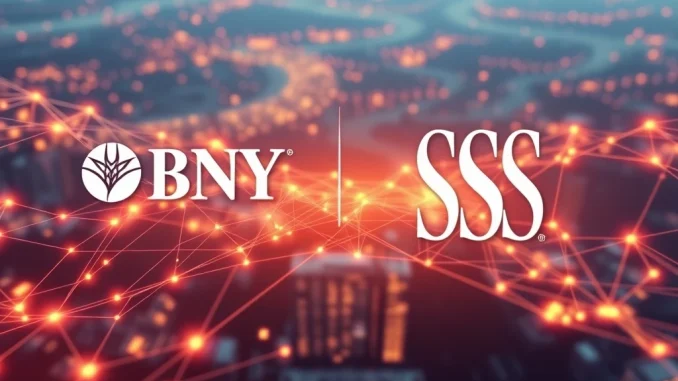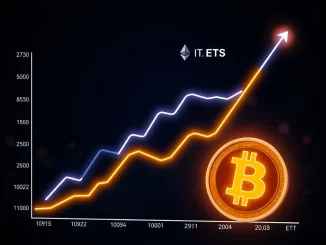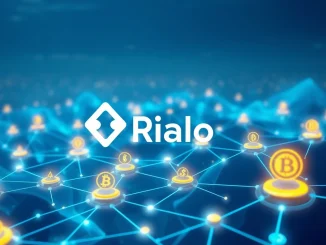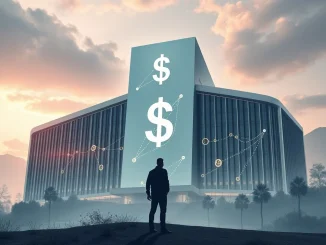
A seismic shift is underway in the world of institutional finance. Two titans, BNY Mellon and Goldman Sachs, have joined forces to integrate digital asset tokenization into the colossal $7 trillion global fund market. This isn’t just an upgrade; it’s a fundamental reimagining of how assets are managed, traded, and owned, promising to unlock unprecedented efficiencies and opportunities for institutional investors worldwide.
What is Digital Asset Tokenization and Why Now?
At its core, digital asset tokenization is the process of converting real-world assets or rights into digital tokens on a blockchain. Think of it as creating a digital, programmable share of an asset. This concept isn’t new, but its application to a market as vast as the $7 trillion global fund market marks a significant milestone.
Why is this happening now? Traditional financial systems, while robust, are often plagued by inefficiencies:
- Fragmented Custody: Assets are held across various intermediaries, leading to complex reconciliation.
- Limited Interoperability: Difficulty in moving assets seamlessly between different systems and geographies.
- Slow Settlements: Transactions can take days to finalize, tying up capital.
Blockchain technology offers a compelling solution to these issues. By providing an immutable, transparent, and decentralized ledger, blockchain can streamline operations, reduce counterparty risk, and enable real-time asset transfers. The move by major players like BNY Mellon and Goldman Sachs signifies a maturing landscape where blockchain is no longer just a buzzword but a viable infrastructure for mainstream finance.
The Powerhouse Partnership: BNY Mellon and Goldman Sachs
The collaboration between BNY Mellon and Goldman Sachs is a strategic alignment of strengths. BNY Mellon, a global leader in digital asset custody and administration, brings its extensive experience in safeguarding institutional assets and managing complex financial operations. Their established infrastructure for handling vast sums of client funds positions them perfectly to integrate tokenized assets securely.
On the other side, Goldman Sachs contributes its deep expertise in capital markets, asset management, and investment banking. Their reach among institutional investors and their understanding of market dynamics are crucial for driving adoption and creating new investment products. This partnership is a clear signal that Wall Street’s biggest players are not just observing but actively shaping the future of finance with digital assets.
Targeting the $7 Trillion Fund Market: A Strategic Move
The global fund market, encompassing mutual funds, ETFs, and other pooled investment vehicles, is a behemoth. Its sheer size and liquidity make it an ideal target for tokenization efforts. By digitizing fund structures, BNY Mellon and Goldman Sachs aim to:
- Enhance Liquidity: Tokenized fund shares could trade 24/7 across global markets, bypassing traditional clearinghouse delays and expanding trading windows.
- Enable Fractional Ownership: Potentially allowing smaller investors to access institutional-grade products previously out of reach due to high minimums.
- Reduce Operational Costs: Automating compliance checks, record-keeping, and administrative burdens through smart contracts.
- Improve Transparency: Immutable blockchain records provide a clear, auditable trail of ownership and transactions.
This initiative aligns with a broader industry trend toward ‘programmable’ assets, where smart contracts define ownership rights and obligations. For institutional clients, this means more dynamic capital allocation and potentially significant cost savings.
Unlocking Efficiencies with Blockchain Technology
The true power of this collaboration lies in its leveraging of blockchain technology to address long-standing inefficiencies. Imagine a world where:
- Real-time Trading and Settlement: Instead of T+2 or T+3 settlement cycles, tokenized fund shares could settle almost instantly, freeing up capital faster.
- Automated Compliance: Smart contracts can be programmed to enforce regulatory rules automatically, reducing manual errors and compliance costs.
- Improved Data Management: A single, shared ledger eliminates the need for multiple reconciliations across different systems, reducing operational overhead.
- New Product Innovation: The flexibility of tokenized assets could lead to new types of investment products, tailored liquidity solutions, and more efficient capital formation.
This approach has the potential to fundamentally transform fund structures, making them more agile, efficient, and globally accessible. It’s a testament to the transformative potential of blockchain beyond cryptocurrencies, extending into the very bedrock of traditional finance.
Navigating the Road Ahead: Challenges and Opportunities
While the potential benefits are immense, the path to widespread adoption of digital asset tokenization is not without its hurdles. Key challenges include:
- Regulatory Alignment: Different jurisdictions have varying approaches to digital assets, necessitating complex legal and regulatory frameworks.
- Cybersecurity Risks: As with any digital system, robust security measures are paramount to protect against hacks and data breaches.
- Investor Education: Institutional investors, while sophisticated, will need clear guidance on the implications and benefits of programmable assets.
- Interoperability Standards: Ensuring that tokenized assets can seamlessly interact across different blockchain networks and traditional systems.
Both BNY Mellon and Goldman Sachs have emphasized their commitment to navigating these complexities, signaling a cautious yet forward-looking approach. Their success will depend on demonstrating tangible benefits for clients, including cost savings, enhanced transparency, and expanded market access.
Conclusion: Reshaping Global Capital Markets
The collaboration between BNY Mellon and Goldman Sachs to integrate digital asset tokenization into the $7 trillion fund market is more than just a new product offering; it’s a foundational step towards a next-generation financial infrastructure. It underscores the growing strategic importance of digital assets in institutional finance and demonstrates that major financial institutions are positioning themselves to lead this transition. As other major players evaluate similar opportunities, this initiative could serve as a critical testbed, potentially reshaping the landscape of global capital markets for decades to come. The future of finance is increasingly digital, and this partnership is a powerful testament to that undeniable truth.
Frequently Asked Questions (FAQs)
Q1: What exactly is digital asset tokenization in the context of funds?
Digital asset tokenization, in this context, refers to the process of representing traditional fund shares or interests as digital tokens on a blockchain. These tokens carry the same ownership rights and economic value as traditional shares but benefit from the underlying blockchain technology for faster settlement, improved transparency, and enhanced programmability.
Q2: How will this partnership between BNY Mellon and Goldman Sachs benefit institutional investors?
Institutional investors stand to benefit from several key areas: reduced operational costs due to automated processes, enhanced liquidity through 24/7 trading possibilities, improved transparency via immutable blockchain records, and potentially expanded access to a wider range of investment products through fractional ownership.
Q3: What role does blockchain technology play in this initiative?
Blockchain technology serves as the foundational infrastructure for this initiative. It provides a secure, decentralized, and transparent ledger for recording ownership and transactions of tokenized fund assets. This enables features like real-time settlement, automated compliance via smart contracts, and efficient management of digital rights, addressing long-standing inefficiencies in traditional finance.
Q4: Are there significant challenges to the widespread adoption of tokenized funds?
Yes, significant challenges remain. These include navigating complex and fragmented regulatory landscapes across different jurisdictions, ensuring robust cybersecurity measures to protect digital assets, educating institutional investors about the nuances and benefits of programmable assets, and developing interoperability standards between various blockchain networks and existing financial systems.
Q5: How might this impact the traditional $7 trillion fund market?
This initiative could fundamentally transform the traditional fund market by introducing greater efficiency, liquidity, and accessibility. While it won’t replace traditional funds overnight, it sets a precedent for modernizing fund structures, potentially leading to a hybrid model where both traditional and tokenized funds coexist, with the latter gradually gaining market share due to their inherent advantages.



